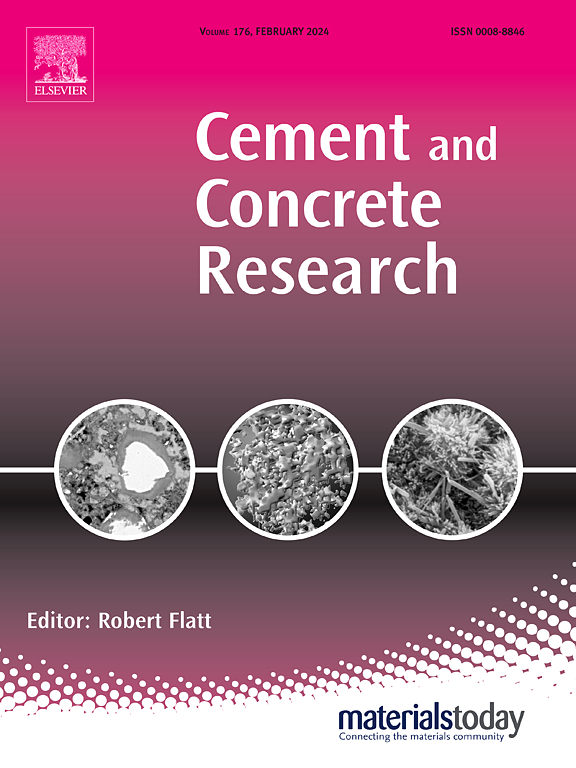补充胶凝材料的水化过程是否影响混合水泥浆体的老化蠕变?
IF 10.9
1区 工程技术
Q1 CONSTRUCTION & BUILDING TECHNOLOGY
引用次数: 0
摘要
在胶凝材料中,矿物相的持续水化和蠕变总是共存的,这使得很难将水化对蠕变测量的影响解耦,而水化对蠕变测量的影响总是与时间相关的。本研究比较了一个真正的水化(老化)系统与等效的水化(非老化)系统。在非老化体系中,在特定年龄(1、7、28和91天)用惰性石英代替未水化相,揭示熟料和补充胶凝材料(SCMs)水化对蠕变的作用机制。结果表明,SCMs的水化过程和钙-铝-硅酸盐-水合物(C-A-S-H)的形态决定了蠕变的大小和动力学。粉煤灰(FA)持续的火山灰反应显著增加了徐变,而渣(SL)共混物中箔状C-A-S-H的形成抑制了渣(SL)共混物的徐变,但在相应时期由于SL反应剧烈而产生了明显的早期徐变。水泥孔溶液中的高钙浓度延缓了熟料的进一步水化,从而略微抑制了徐变的发展。水化引发的SCM和熟料溶解是蠕变的主要原因,而载荷引起的C-A-S-H溶解可能是时效蠕变的主要原因。本文章由计算机程序翻译,如有差异,请以英文原文为准。
Does the hydration process of supplementary cementitious materials affect the aging creep of blended cement paste?
In cementitious materials, continuous hydration of mineral phases and creep always coexist, making it difficult to decouple the effect of hydration on creep measurements, which are invariably time-dependent. This study compares a real hydration (aging) system with an equivalent hydration (non-aging) system. In the non-aging system, the unhydrated phase was replaced with inert quartz at specific ages (1, 7, 28, and 91 days) to uncover the mechanism of clinker and supplementary cementitious materials (SCMs) hydration on creep. The results show that the hydration process of SCMs and morphology of calcium-aluminate-silicate-hydrates (C-A-S-H) dominate the creep magnitude and kinetics. The ongoing pozzolanic reaction of fly ash (FA) significantly increases creep, whereas the formation of foil-like C-A-S-H in slag (SL) blends inhibits its creep, except for the significant early-age creep due to the steep reaction of SL at the corresponding period. The high calcium concentration in cement pore solution delays the further hydration of the clinker, thereby slightly inhibiting the development of creep. The hydration-triggered dissolution of SCM and clinker contributes to creep development, whereas the load-induced dissolution of C-A-S-H may account for aging creep.
求助全文
通过发布文献求助,成功后即可免费获取论文全文。
去求助
来源期刊

Cement and Concrete Research
工程技术-材料科学:综合
CiteScore
20.90
自引率
12.30%
发文量
318
审稿时长
53 days
期刊介绍:
Cement and Concrete Research is dedicated to publishing top-notch research on the materials science and engineering of cement, cement composites, mortars, concrete, and related materials incorporating cement or other mineral binders. The journal prioritizes reporting significant findings in research on the properties and performance of cementitious materials. It also covers novel experimental techniques, the latest analytical and modeling methods, examination and diagnosis of actual cement and concrete structures, and the exploration of potential improvements in materials.
 求助内容:
求助内容: 应助结果提醒方式:
应助结果提醒方式:


